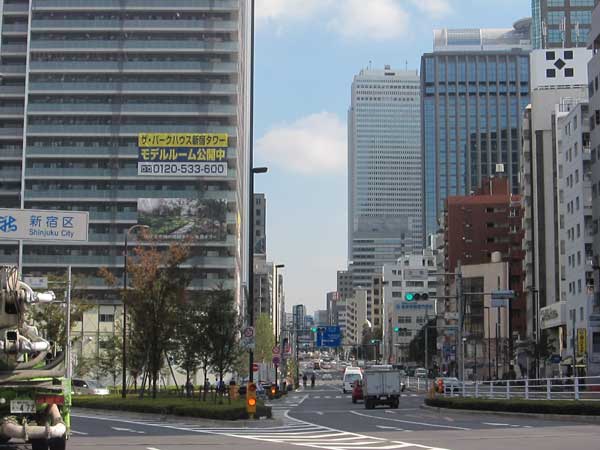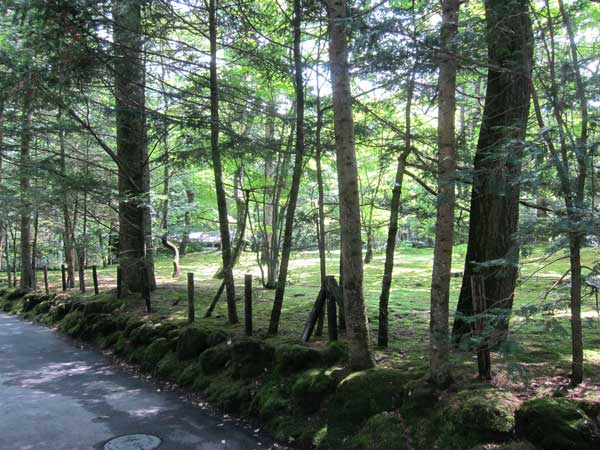
5月でも、長野の山の頂に雪が残っています。森は目覚めたばかりです。

家の近くに、「ダブルフィイス」というビルが建てられています。看板のまんなかに、モデルさんがいて、背景の半分は建物で、もう半分には森があります。実際には、木は1つも植えないみたいです。ところで “double-faced” は英語で「偽善」という意味もあります。
I assume Double Face has no specific meaning in Japanese. It’s hard to imagine the phrase being used in marketing when confidence and reputation are at stake.
Near my house is another new construction, Double Face in katakana or just Face Face in English. The concept is city and nature. But from what I see the building itself will contribute almost zero natural benefits to the sidewalk or community. Not even a single tree outside the mid-rise building. Again, I can sort of understand the concept, but the execution as a billboard and as a property leave much to be desired.
At this point in construction, what they’re offering the public is a vending machine, one of many drink machines along this boulevard.

I love this path that starts at Shinjuku Dori, near the department stores, cuts between Kabukicho and Golden Gai, and ends up at the start of the male host zone in eastern Shinjuku. I wish all my city walking could be done on this narrow green path with mature trees.


路地からこぼれ出ているカシワバアジサイという花がきれいです。夏に咲いていますが、もともと東南アメリカの森から来ました。普通のアジサイのより、葉も花も違います。東京の建物の森で、この植物は自分のふるさとを思い出すでしょうか?
I love this late blooming summer hydrangea with white flowers spilling from the side street onto the main road near our place. It’s called “Oakleaf hydrangea” or kashiwaba ajisai in Japanese. It’s native to hardwood forests in the southeastern United States. In addition to distinctive leaves, it’s one of the few hydrangeas with cone-shaped flower bunches. Maybe built-up Tokyo reminds this bush of its native forest.

最近、贅沢な不動産開発が自然のイメージを広告に使っています。広告の中の田舎の森や現場から離れた風景を見ていると妙な 気持ちになります。本当の都市の森を作れば、不動産の価格はもっと上がります。西新宿で都市の森はどんな風に見えるだろう。
I’ve noticed recently more and more real estate advertising at construction sites and at recently completed buildings that show images of forests or famous urban landscapes that are nowhere near the location. A new luxury development rising at Jingumae 3 chome #37, the site of the former Harajuku Danchi, shows a photo of the ginko trees turning yellow on Icho Namaiki (いちょう並木).
Above is Nishi Shinjuku, which has several new office towers and new apartments on Ome Kaido, towards Nakano Sakaue. Following regulations, these buildings have planted street trees. But it is comical to see the image of a path meandering through a forest that’s half way up the new apartment building.
On the one hand, it’s good to see city people still dream of forests. On the other hand, these wealthy developers and the City of Tokyo regulators could increase the value of their properties by actually turning this marketing image into a reality.
What could an urban forest look like at this intersection?

十月にヒマワリを見たから、驚いた。日本に来たオランダの友達によると、アムステルダムはもう冬みたいだそうです。駅周りに小さい森を作るといいと思います。今のところ、このヒマワリたちが素敵な気晴らしになっています。
I was surprised to see these sunflowers blooming in late October. Dutch visitors @tanemaki2011 reminded me that in Europe it’s already early winter, with temperatures already reaching 0 degrees. For an Amsterdam resident, Tokyo fall is like summer yet better.
There’s currently a lot of construction around the Nakano JR station, with new bus areas, exits, and plazas to support an enormous high-rise office building and tall residential towers. I hope they will radically rethink the public space around the station. It’s the center of communal life, yet now mostly revolves around autos, asphalt, and concrete. It would be great to see a livelier meeting place.
A mini-forest would be inviting. In the meantime, this small field of sunflowers is a welcome distraction.

渋谷のビルの上に、小さな森があります。宮下公園の斜め前にあって、このビルには店とギャラリーと事務所が入っています。こんなに木が見えて、自然光を使っている事務所は良さそうです。明治通りからは、この小さな空の森が見えませんが、渋谷のBear Pondコーヒーからはよく見えます。
Recently I have been drinking coffee at Bear Pond on the street that connects Miyashita Park and Aoyama. On these hot days, it’s great to look up and see a vertical forest on this 10 story mid-rise that combines retail, gallery, and office space. It’s easy to miss this from Meiji Dori, but you can see it easily from the Bear Pond coffee shop. it must be great to work surrounded by thick trees and natural light. It also looks like you can walk between the top three levels.


夏の軽井沢は涼しいです。自転車でまわって、苔の森や小川や池を見ました。東京から日帰りでも楽しいです。ジョンレノンとヨーコオノがよくたずねた喫茶店を見つけました。
In the heat of summer, Karuizawa remains cool and elegant. We found a moss forest, streams, and a small lake. It is just an hour from Tokyo by bullet train, and easy to rent a bike near the station. We passed many tennis courts, but did not meet any royalty. By accident, we met the charming proprietress of a coffee shop frequented by John Lennon and Yoko Ono in 1977.

Miniature pine forest outside Japan Supreme Court. In 1970s, traditional garden joined Brutalist architecture. Would love to see traditional garden with urban forest today.
最高裁判所の外にすてきな松の小さな森がある。70年代に日本庭園とブルータリスム建築は一緒になった。将来は日本庭園と都市の森は一緒になれるかな。
Walking in Chiyoda-ku opposite the Imperial Palace, I saw this forest of beautiful stunted pine trees above a stone wall. At eye level, there appear to be hundreds of carefully twisted pines whose canopy is less than one meter from the ground. Behind this gorgeous sea of needles is the Supreme Court of Japan (最高裁判所), a 1974 Brutalist concrete building that won awards for its architect Shinichi Okada.
I love the stone wall and the pine forest. In my dream, the once avant-guarde building could regain its ぷprominence by using the concrete structure to support a dense urban forest on its walls and roof. The wildness of the forest hill would contrast nicely with the austere pine forest serving as a formal moat to this newly enlivened public building. The contrast would be magnificent.
While I love the chaos of DIY gardens and the lushness of urban forests, there is also room for traditional Japanese gardens and techniques in the urban landscape, particularly around important public buildings. The contrast between heavily manipulated and more natural landscapes is a new concept at which Tokyo can excel.
